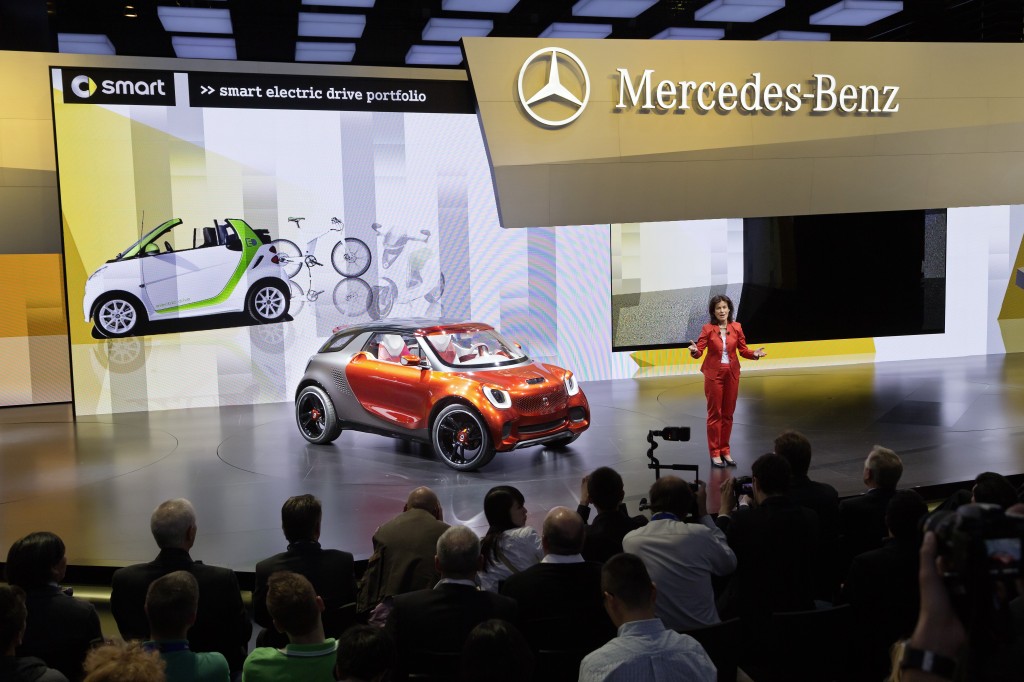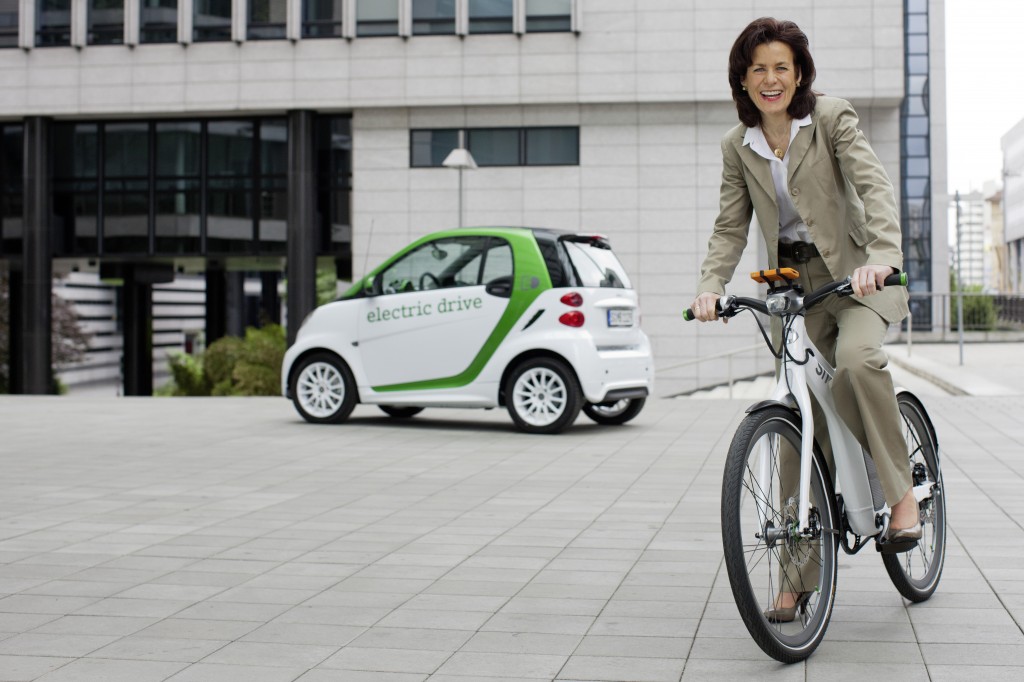Interview: Head of Smart, Annette Winkler
Daimler's city car brand to get smarter
By John LeBlanc TORONTO - When she took over as the boss at Daimler’s Smart brand two years ago, Annette Winkler knew full well what she was getting herself into. With Smart’s one offering — the iconic ForTwo two-seater that arrived in Europe in 1997 and in Canada in 2004 — not due for a replacement for another four years, newer premium city cars like the Fiat 500 and Mini Cooper were stealing away customers; to the point where global Smart sales were down by about one-third from just over 140,000 sold annually in 2005. Yet Despite the less-than rosy situation, Winkler, a rare female executive in the traditionally testosterone-driven auto industry, decided to make lemonade from the bag of lemons she was handed. “Some people even asked me, How would you survive until the new product arrives?” the head of Smart admitted during a media roundtable on a visit to Canada. Winkler’s answer was to take advantage of the ForTwo’s inherently urban-friendly nature. “No other car company makes a 2.69 metre car,” Winkler says, referring to the ForTwo’s distinctive lack of length. “So we are bringing that advantage back to the customers.” Winkler’s survival plan includes lots of promotion of the limited-volume, all-electric version of the ForTwo, its new Car2Go car sharing program, creating special Smart-exclusive parking spots and launching a pair of Smart-branded vehicles even smaller than the ForTwo: the new E-Bike and E-Scooter. Winkler says the original 1990s ForTwo was designed for gas and electric engines. So the new ForTwo Electric Drive (which goes on-sale in Canada next spring from $26,990 for the coupe and $29,990 for the cabriolet) is a natural. Already, orders in Canada are outstripping the available supply. The Smart E-Bike arrives next year in Canada with the E-Scooter in 2014 (prices unknown yet). When asked why an automaker is also offering two-wheelers, Winkler says that the Smart brand stands for “urban mobility”, and with ever-increasing city congestion and pollution, electric two wheelers take up less space and emit less emissions than cars. Smart is also working with its dealers in various cities across Canada and the world to provide special Smart parking spaces, and a smart phone app that would allow Smart owners to search for such discounted spaces or find a Smart Car2Go service when traveling. But Winkler wasn’t made head of Smart to sell some iPhone apps. In 2010, Daimler (which is the German parent of both Smart and sister Mercedes-Benz) decided to start investing heavily big in the small car brand. A decision was made to partner with France’s Renault for a new generation of the ForTwo two-seater, and once again offer a four-seater Smart. The new-generation of Smarts won’t go on-sale in Europe until late 2014, with the ForTwo arriving in Canada as a 2015 model, and the ForFour yet to be signed-off for sale here. But from the series of show cars Smart has been presenting over the past two years to prepare the public for what the next generation of its cars may look like, the latest, the ForStars from this year’s Paris show, is the concept Winkler admits gives the most clues as to where the design of the new Smart family is headed.
Yet despite the concepts displaying a variety of body styles (from coupes to pickups) , Winkler says a two-seater and four-seater are the only new Smarts on the way. “I speak to customers. They are not asking for new models, like a roadster. They want the car like it is.”
Unlike the ill-fated 2004 to 2006 ForFour —essentially a re-clothed Mitsubishi Colt that didn’t have the ForTwo’s Tridion safety cell and was front- instead of rear-wheel-drive — the new model will be built off the same platform as the ForTwo, But the head at Smart also recognizes that competitive pricing will be a necessity. With a starting price of $14,400, the ForTwo runs up against roomier and more powerful conventional subcompacts — like an $11,878 Nissan Versa Sedan. Will we see a drastic price reduction when the new generation of Smarts arrive?
Winkler can’t give specific pricing details. But she did say because the four-seater will compete with other four-seaters, it would offer a “premium price for a good price/value proposition.”
Some cost savings will come from the Smarts and the next Renault Twingo sharing a rear-engined, rear-wheel drive platform. And while the ForTwo will continue to be built in Smart’s French facility, the ForFour will be built in a Slovenian Renault plant.
Just don’t expect to see a $10,000 Smart in the future.
Winkler says, “The new price will be relative. What’s more important is the price/value relationship — what's in the car, the content. If you see the new Smart compared to what you will get with its equipment, our customers will be very happy"
But Winkler wasn’t made head of Smart to sell some iPhone apps. In 2010, Daimler (which is the German parent of both Smart and sister Mercedes-Benz) decided to start investing heavily big in the small car brand. A decision was made to partner with France’s Renault for a new generation of the ForTwo two-seater, and once again offer a four-seater Smart. The new-generation of Smarts won’t go on-sale in Europe until late 2014, with the ForTwo arriving in Canada as a 2015 model, and the ForFour yet to be signed-off for sale here. But from the series of show cars Smart has been presenting over the past two years to prepare the public for what the next generation of its cars may look like, the latest, the ForStars from this year’s Paris show, is the concept Winkler admits gives the most clues as to where the design of the new Smart family is headed.
Yet despite the concepts displaying a variety of body styles (from coupes to pickups) , Winkler says a two-seater and four-seater are the only new Smarts on the way. “I speak to customers. They are not asking for new models, like a roadster. They want the car like it is.”
Unlike the ill-fated 2004 to 2006 ForFour —essentially a re-clothed Mitsubishi Colt that didn’t have the ForTwo’s Tridion safety cell and was front- instead of rear-wheel-drive — the new model will be built off the same platform as the ForTwo, But the head at Smart also recognizes that competitive pricing will be a necessity. With a starting price of $14,400, the ForTwo runs up against roomier and more powerful conventional subcompacts — like an $11,878 Nissan Versa Sedan. Will we see a drastic price reduction when the new generation of Smarts arrive?
Winkler can’t give specific pricing details. But she did say because the four-seater will compete with other four-seaters, it would offer a “premium price for a good price/value proposition.”
Some cost savings will come from the Smarts and the next Renault Twingo sharing a rear-engined, rear-wheel drive platform. And while the ForTwo will continue to be built in Smart’s French facility, the ForFour will be built in a Slovenian Renault plant.
Just don’t expect to see a $10,000 Smart in the future.
Winkler says, “The new price will be relative. What’s more important is the price/value relationship — what's in the car, the content. If you see the new Smart compared to what you will get with its equipment, our customers will be very happy"
04.30.13 | Features, Interviews, Mercedes-Benz, Smart | Comments Off on Interview: Head of Smart, Annette Winkler





